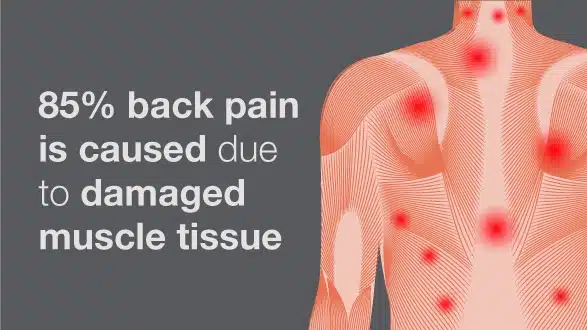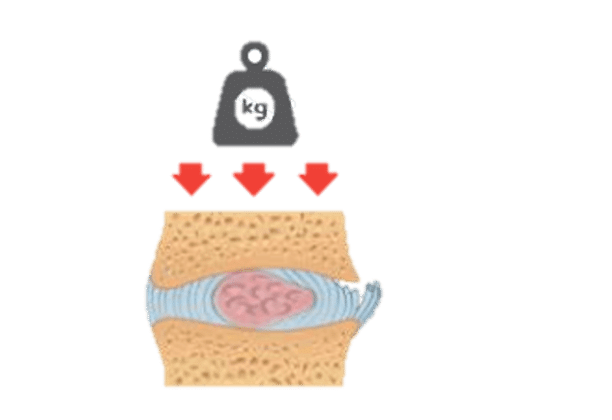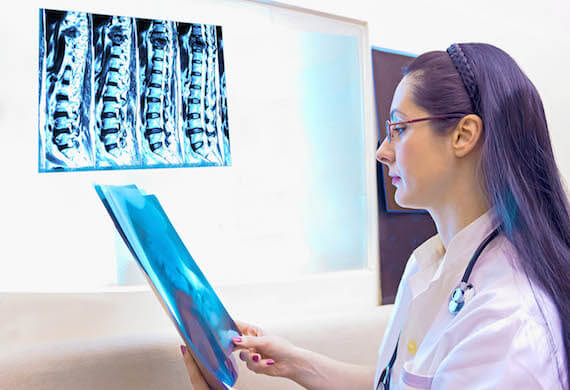Request Appointment
Enter your details and we will be in touch with you shortly;
Or call
8655885566
between 8 am and 8 pm.

Sharp pain or dull ache in the upper, mid or lower back which may keep returning or increasing

Back pain is a common condition affecting 8 out of 10 adults and is the number one reason for disability in the world. The intensity of pain differs from person to person.
Back pain is more common in the lower back region, also known as lumbago. Backache can be felt anywhere along your spine, from your neck to your hips. Appropriate back pain treatment is essential to relieve your back pain symptoms. Backache can range from a muscle ache to a shooting, stabbing, or burning sensation.
The pain might spread down your leg or worsen with movements like bending, twisting, lifting, walking, or standing. The back pain is considered chronic if it lasts for more than 12 weeks. People who suffer from back pain experience any combination of the following symptoms:
 Professional diagnosis required
Professional diagnosis required Chronic, can last for years
Chronic, can last for years Treatable with 4 weeks of QI Spine Therapy
Treatable with 4 weeks of QI Spine TherapyUnderstanding the causes of back pain is the first step toward effective pain management and prevention. Often, back pain results from a combination of factors that stress the muscles, ligaments, and joints. Whether it’s from a sudden injury, repetitive strain at work, or lifestyle factors such as inactivity and poor posture, each cause requires careful attention. By identifying these factors early, individuals can work with healthcare professionals to implement preventive measures and tailor back pain relief therapy.
Many conditions are linked to back pain causes, which are mentioned below:
 Professional diagnosis required
Professional diagnosis required Chronic, can last for years
Chronic, can last for years Treatable with 4 weeks of QI Spine Therapy
Treatable with 4 weeks of QI Spine TherapyPain can be temporarily relieved by hot and cold compresses. In addition to the methods, modern approaches now offer advanced back pain therapy options that integrate multiple strategies. For example, many patients benefit from Physical therapy sessions, where Pain relief exercises and Spinal adjustments are routinely recommended to ease discomfort. A proper diagnosis is important to provide the best back pain treatment.
Combining massage therapy, yoga, and some lifestyle changes. You have plenty of non-surgical treatment options to address back pain and accelerate recovery, and promote healing. However, a more holistic and long-lasting approach involves spine rehabilitation using:
You can prevent back pain or avoid its recurrence by keeping your back healthy and strong. You should do the following to maintain your back and spine: -
Sometimes, back pain isn’t a stand-alone pain, and other symptoms may appear along with back pain. If such symptoms occur, then you should consider visiting a spine doctor immediately and get suitable back pain relief treatment: -
 Professional diagnosis required
Professional diagnosis required Chronic, can last for years
Chronic, can last for years Treatable with 4 weeks of QI Spine Therapy
Treatable with 4 weeks of QI Spine Therapy Professional diagnosis required
Professional diagnosis required Chronic, can last for years
Chronic, can last for years Treatable with 4 weeks of QI Spine Therapy
Treatable with 4 weeks of QI Spine TherapyYour physician will check your complete medical history and also conduct a physical examination to identify the root cause of back pain. Neurological tests involving sensation and function assessment may be carried out to determine the root cause of pain and devise an appropriate back pain therapy.
Function, reflexes, flexibility, and range of motion are assessed during movements like walking, bending forward and backward, etc. Besides, blood tests may be needed to look for signs of infection, inflammation, etc.
Often, it may become difficult to identify the exact cause of back pain, since there are so many reasons. If the cause is not clear, sometimes, you may be asked to get a few imaging tests to rule out specific causes of pain, including tumors, etc. These tests are as follows:
Accurate diagnosis is essential to a proper back pain treatment program. As the doctors at QI Spine are trained for several hours in spine conditions alone, they have the expertise to diagnose the cause of back pain accurately. A detailed medical analysis is carried out with digital spine analysis, including pain history, range of motion, and testing of nerves and muscles.
 Professional diagnosis required
Professional diagnosis required Chronic, can last for years
Chronic, can last for years Treatable with 4 weeks of QI Spine Therapy
Treatable with 4 weeks of QI Spine Therapy






Have a question?
Ask our spine specialists
Who is a QI Spine Specialist?
A QI Spine Specialist is a medical expert with

Dr. Nidhi Sanghvi Shah

Dr. Shital Gaikwad

Dr. Richa Bhatia
9000 hours
of specialisation in treating back and neck conditions
32 hours
of spine physiotherapy specialisation methods in McKenzie concepts, Kinetic control, Neurodynamic solutions, Mulligan’s concepts
500 hours
and 6 months of QI Spine specialisation courses
A proper diagnosis is crucial to determine the appropriate chronic back pain treatment.
Yes, combining physical therapy, massage therapy, Yoga, and other techniques provides significant relief.
If symptoms persist or worsen, it’s important to seek professional evaluation for suitable back pain relief therapy.
Your back might hurt due to minor muscle strain or sprain or muscle overuse. At times, certain diseases or serious damage/injury can also hurt your back severely.
Poor posture, stress, lack of exercise, and a sedentary lifestyle can aggravate or contribute to your back pain.
DSA stands for digital spine analysis. It is a precise test that measures the strength, mobility, and balance of all the elements of the spine’s muscular components. DSA helps in diagnosis and back pain treatment.
You have plenty of self-care measures that you can do at home to get rid of back pain – exercises, hot and cold therapy, painkillers, massage therapy.
Your back pain may be serious if you notice signs – a fever of 38oC or above, unexplained weight loss, loss of bladder/bowel control, constant back pain
Exercise releases a chemical substance called endorphins, the body’s natural painkillers. Specific exercises performed regularly as advised by your spine specialist can relieve your back pain.
The types of backache are acute, sub-acute, and chronic. Acute back pain is severe that lasts for 7 to 10 days generally. Sub-acute pain lasts from 2 to 6 weeks. Chronic back pain lasts longer than 6 to 8 weeks.
Lumbago or low back pain is the most common reason for back pain than upper or middle back pain; while upper and middle back pain is less common.
It is not true in all cases. Surgery is not required in the majority of back pain treatment cases.
You can prevent back pain by maintaining back health. Regular exercise including stretching and strengthening will strengthen your back muscles and thereby maintain spine health too.